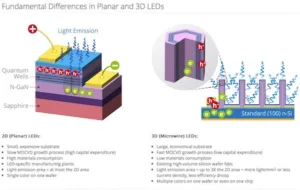We have reported before on Aledia, the French developer of LED displays, in “Aledia Uses Nanowires for MicroLEDs” and “IC06 Aledia Wants to Disrupt Displays” last year. The nanowire-based technology is promising higher brightness at lower display cost for high resolution mobile displays. Instead of using discrete LED chips that have to be assembled, Aledia is using a Si wafer to grow the GaN LEDs directly on the wafer. Backplane and light emitting structures in one process. While this looks at first glance as a waste of a Si wafer, they do not use the more expensive Sapphire substrates to make the LED chips.
Credit: Aledia – 3D Nanowire Technology
To further their development efforts the firm has closed a round C funding process with a total of €30 million ($36 million). The participants included most of the old partners and has added Intel Capital to the list. There are still no real display makers among the investors, but Intel could have potentially some interest in this technology.
Aledia said in their press release that this Series C financing will support the company’s plans to significantly accelerate the speed of its LED technology development, including acquiring critical equipment.
Analyst Comment
This is a new technology that offers an alternative solution to the micro LED assembly issues. This is very early in the development and I am looking forward to future demonstrators proving the potential of this approach. Coming out of LETI, Aledia has certainly a long history in emissive displays, even though none has been a commercial success.
Based on the interesting quantum well structure, the display should have a good viewing angle even if there is somewhat of a forward preference for the photons. The real question is the achievable color quality and brightness uniformity. While the brightness uniformity is dealt with on a statistical level by having many emitters per pixel, the color coordinates are related to the emitter structure which will have some variation through the production process. This could be a good thing or a bad thing depending on how big the variation will be. (NH)

